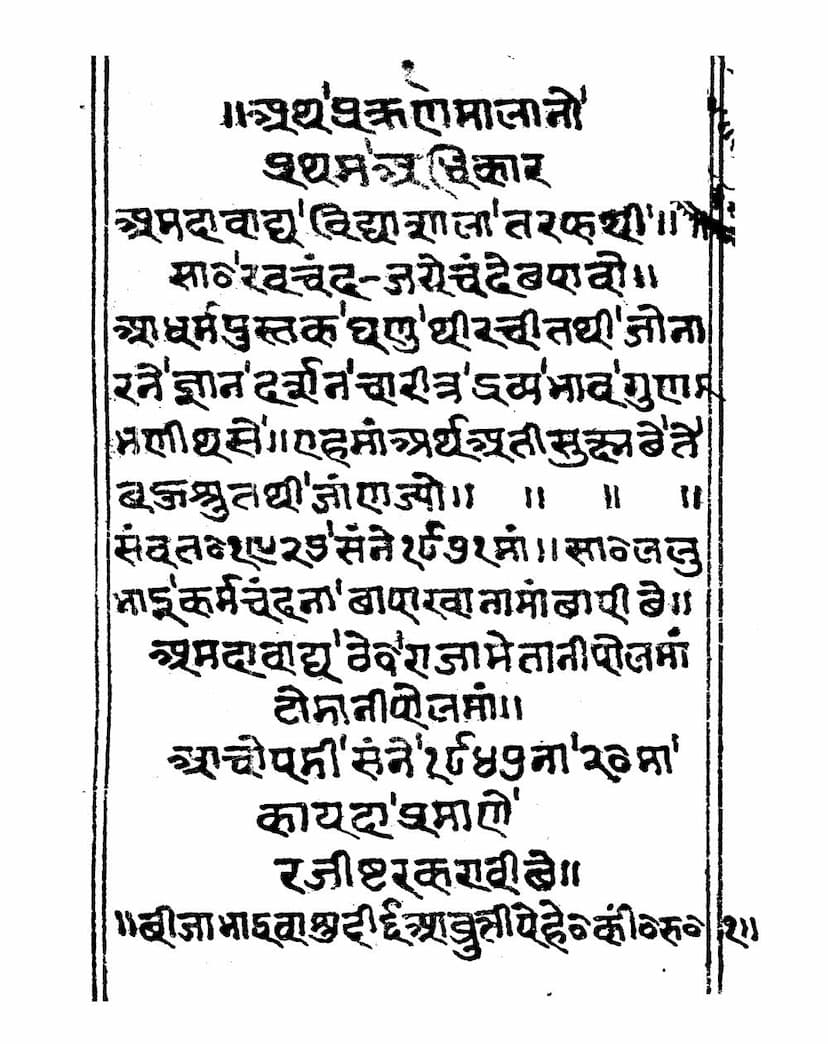Mantradhikar
Added to library: September 2, 2025

Summary
The provided text is a Jain scripture titled "Mantradhikar," authored by Ahmedabad Vidyashala. It is a religious and philosophical text offering guidance on various spiritual practices and principles within Jainism.
Here's a comprehensive summary of the key themes and content based on the provided pages:
Core Jain Principles and Practices:
- Knowledge, Perception, Conduct (Gyan, Darshan, Charitra): The text emphasizes the importance of these three pillars of Jainism for achieving liberation. It speaks of gaining knowledge of reality (dravya and bhava).
- Spiritual Goals: The ultimate goal is described as achieving liberation and a state of true spiritual well-being.
- Ahimsa (Non-violence): While not explicitly detailed in all passages, the underlying principles of Jainism, which center on non-violence, are likely to be interwoven throughout the text.
- Devotion and Worship: The text mentions reverence for Tirthankaras (like Shri VeerVijayji, Shri Vijayji) and devotion to Jain principles.
- Asceticism and Observances: It alludes to various practices like fasting, meditation, and adherence to vows, which are central to Jain spiritual life.
- Purity of Mind and Action: The text stresses the importance of pure intentions and actions in all aspects of life.
Cosmology and Jain Philosophy:
- Jambudweep and other geographical/cosmological descriptions: There are detailed descriptions of Jambudweep, its mountains (like Mahameru, Hemvant, Gandhamadan), rivers, and various regions. This is a common feature in Jain texts that outline the Jain cosmology.
- Types of Beings (Jivas): The text discusses different types of souls and their characteristics, including their lifespan, body structure, and sensory capabilities (e.g., Ekendriya, Beindriya, Trilok Jinababa).
- Karma and its effects: The concept of karma and how it binds souls, as well as the mechanisms for its shedding (nirjara), are fundamental to Jainism and are likely explored.
- The Nature of Reality: The text touches upon the nature of substances (dravya) and their manifestations (bhava), which is crucial for understanding the Jain ontological framework.
- Cycles of Birth and Rebirth (Samsara): The continuous cycle of birth, death, and rebirth is a central theme, with the text guiding towards breaking free from this cycle.
Specific Content and Structure:
- Table of Contents (Anukramanika): The initial pages seem to contain a table of contents or an index, listing various topics or chapters with corresponding page numbers. These include names of various Jain works, concepts, and individuals.
- Detailed Descriptions: The text provides specific details about:
- Lifespans of different beings: It outlines the lifespans of beings in various realms (heavenly beings, hellish beings, humans, animals, plants).
- Body structures and sizes (Avagahana): The physical dimensions and formations of different types of beings are described.
- Types of plants and their characteristics: There are descriptions of various plants and their classification (e.g., ordinary plants, individual plants).
- Types of Karma: The text likely details the different types of karma and their impact.
- Types of Conduct (Charitra): Various forms of virtuous and non-virtuous conduct are discussed.
- Stages of the Soul: The text might describe the progressive stages of spiritual development.
- Mantras and their Significance: As the title suggests, the book likely delves into the significance and application of specific mantras in Jainism, possibly for spiritual advancement or protection.
- Invocations and Prayers: The text probably includes prayers and invocations to Jain deities and Tirthankaras.
- Narratives and Examples: Jain scriptures often use stories and examples to illustrate spiritual principles.
Publisher and Context:
- Ahmedabad Vidyashala: The publisher indicates that this text is an educational resource, likely aimed at providing Jain knowledge and understanding. The "for private and personal use only" notice suggests it's intended for educational dissemination within a specific context.
- Historical Context: The registration details (Samvat 1972, Samvat 1947) point to the publication having a historical origin, likely related to the early to mid-20th century.
Overall Tone and Purpose:
The "Mantradhikar" appears to be a comprehensive guide for Jain spiritual practice, encompassing philosophical understanding, cosmological details, and practical observances. It aims to illuminate the path to spiritual purity and liberation for its readers. The text is rich in Jain terminology and concepts, requiring a background in Jain philosophy for complete comprehension.